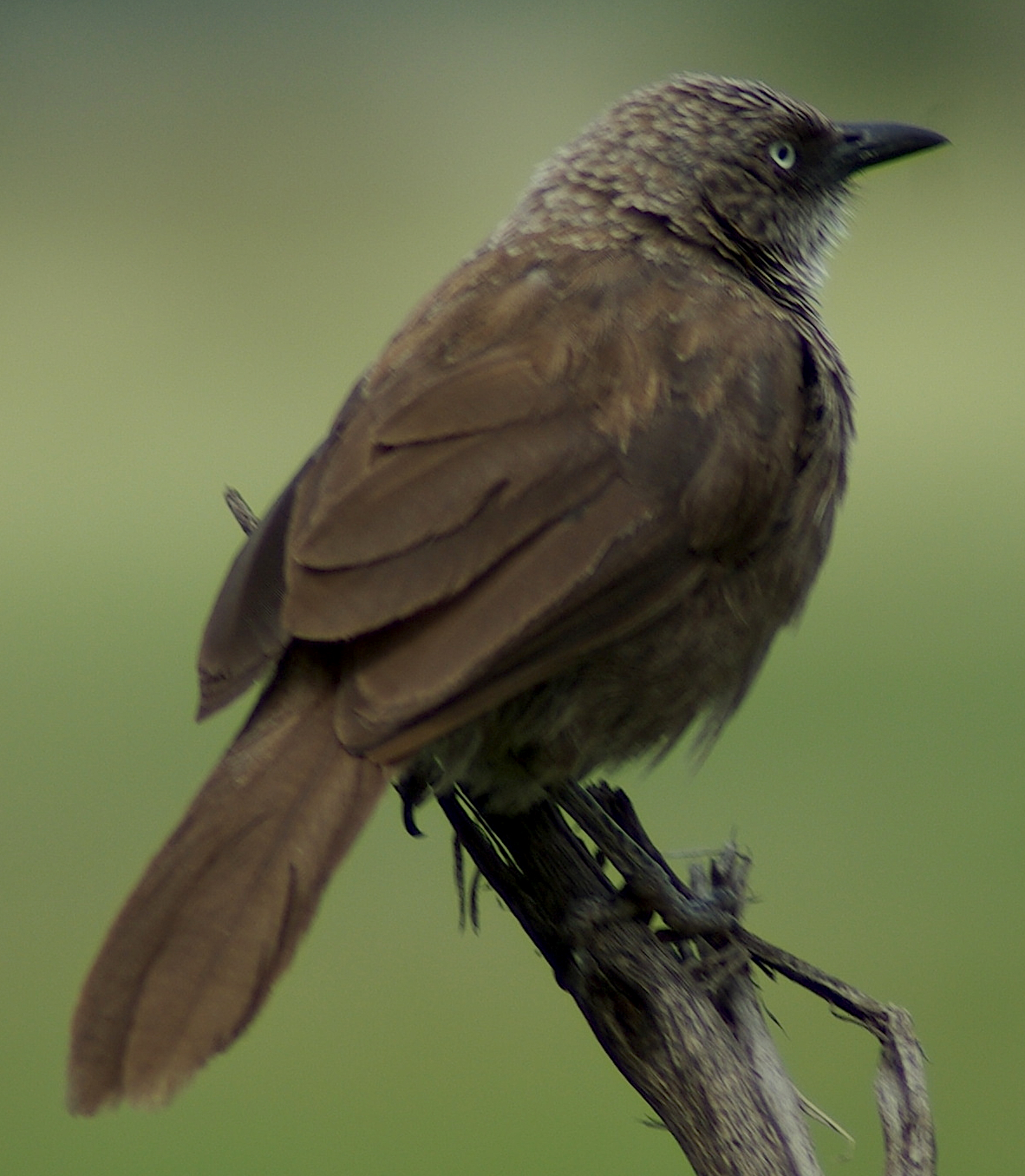- Black-lored Babbler
Taxobox
name = Black-lored Babbler

image_caption = "T. m. vepres" (or "T. sharpei vepres")
status = LC | status_system = IUCN3.1
regnum =Animalia
phylum =Chordata
classis =Aves
ordo =Passeriformes
familia =Timaliidae
genus = "Turdoides "
species = "T. melanops"
binomial = "Turdoides melanops"
binomial_authority = (Hartlaub, 1867)
synonyms =The Black-lored Babbler ("Turdoides melanops") is a species of
songbird in theTimaliidae familyCollar, N. J. & Robson, C. 2007. "Family Timaliidae (Babblers)", pp. 70–291 in; del Hoyo, J., Elliott, A. & Christie, D.A. eds. "Handbook of the Birds of the World ", Vol. 12. Picathartes to Tits and Chickadees. Lynx Edicions, Barcelona.]As defined here, it consists of two populations with widely separated ranges, one in northwestern
Botswana , northernNamibia ,cite book | author = Sinclair, Ian; Hockey, Phil; and Tarboton, Warwick | year = 2002 | title = Birds of Southern Africa | publisher = Princeton University Press | pages = 308–309 | id = ISBN 0-691-09862-1 | url = http://www.amazon.com/gp/reader/0691096821/ref=sib_dp_pt/103-7769821-1663055#reader-link | accessdate = 2007-08-04] andAngola ;BirdLife International 2004. [http://www.iucnredlist.org/search/details.php/52745/all Turdoides melanops] . [http://www.iucnredlist.org 2006 IUCN Red List of Threatened Species. ] Downloaded on 27 July 2007.] the other in southwesternKenya ,cite book | author = Zimmerman, Dale A.; Turner, Donald A.; and Pearson, David J. | year = 1999 | title = Birds of Kenya and Northern Tanzania, Field Guide Edition | publisher = Princeton University Press | pages = 196–197, 435 | id = ISBN 0-691-01022-6 | url = http://www.amazon.com/Birds-Kenya-Northern-Tanzania-Field/dp/0713663057/ref=sr_1_1/103-7769821-1663055?ie=UTF8&s=books&qid=1185557975&sr=8-1 | accessdate = 2007-07-26]Tanzania ,Uganda ,Burundi ,Rwanda , and the part of theDemocratic Republic of the Congo immediately adjacentcite web | last = Pedersen | first = Tommy | year = 2001 | title = Democratic Republic of CONGO - A bird checklist | url = http://www.birdlist.org/downloads/Congo-acompletechecklist.zip | accessdate = 2007-08-03 | format = zip See also [http://www.tommypedersen.com/DRC.htm this site] where one can request an updated checklist.] to the three last-named countries.BirdLife International 2004. [http://www.iucnredlist.org/search/details.php/52750/all Turdoides sharpei] . [http://www.iucnredlist.org 2006 IUCN Red List of Threatened Species. ] Downloaded on 2007-08-04.] Like other "Turdoides", it is found low or on the ground in or near dense woody vegetation, including in cultivated areas.Description
Both populations are 21 to 25 cm (8 to 10 inches) long. Birds are largely grayish brown with geographically and individually variable white mottling, especially below. The population near
Nanyuki , Kenya, is darker but can have a pure white chin or entire throat. The combination of pale yellow or white eyes and black lores (the areas between the eye and the bill) separates this species from similar babblers, though all juvenile babblers have brown eyes.In southern Africa, the calls are described as "A nasal 'wha-wha-wha' and a harsh, fast 'papapapa'." In Kenya, single birds give repeated single or double harsh notes such as "waaach" or a muffled "kurr-ack"; pairs or groups give longer phrases in chorus. The tempo is frequently slow for a babbler. They are most vocal in the early morning and late afternoon.cite book | author = Zimmerman, Dale A.; Turner, Donald A.; and Pearson, David J. | year = 1996 | title = Birds of Kenya and Northern Tanzania | publisher = Princeton University Press | pages = 196–197, 435 | id = ISBN 0-691-02658-0 | url = http://www.amazon.com/Birds-Kenya-Northern-Tanzania-Zimmerman/dp/0691026580/ref=si3_rdr_bb_product/103-7769821-1663055 | accessdate = 2007-08-04]
Behavior
Southern birds forage in leaf litter and are "much more furtive than the other babblers". However, Kenyan birds forage in bushes and tall grass; they are "restless, noisy, and suspicious" and "typical gregarious babblers".
Taxonomy
The two populations are treated here as a single species following the "Handbook of the Birds of the World" and other authorities. Some authorities consider the northern form a separate species, "Turdoides sharpei". [cite web | title = ABC African Checklist (passerines) | year = 2006 | last = Lack | first = Peter | publisher = African Bird Club | url = http://www.africanbirdclub.org/resources/passerines_2006.doc | format = doc | accessdate = 2007-08-04]
References
Wikimedia Foundation. 2010.
